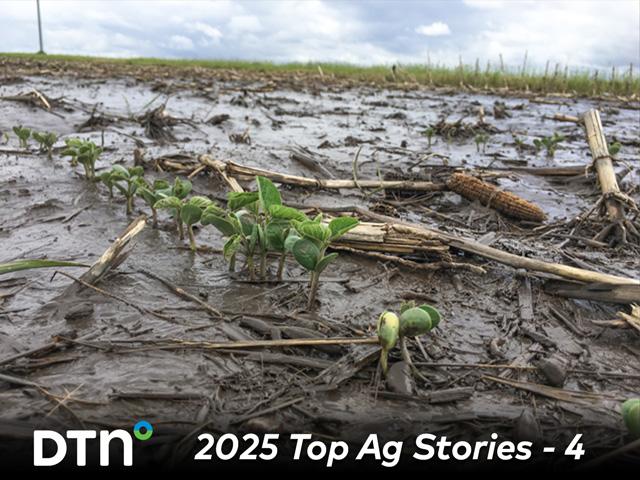
More than anything, I believe traders' positive interaction throughout the marketplace on Monday again shows hard evidence their core desire is to push the contracts higher as they know and...
Crude oil futures tumbled more than 2% by Friday's close, reversing a steady morning session.

No. 5 on DTN's list of the Top 10 Ag Stories of the Year focuses on how, with a waning La Nina and largely neutral conditions for the spring and...

Copeland and Sons Herefords ranch spans six generations in New Mexico. The family improves cattle genetics and land while building a legacy for...
P[] D[0x0] M[0x0] OOP[F] ADUNIT[] T[]
ShayLe Stewart is the newest member of the DTN analysis team (September 2019), and comes with deep roots in the beef industry.
Based in the high mountain cattle country near Cody, Wyoming, Stewart leads coverage in all areas of livestock and meat production, and brings a true boots-on-the-ground perspective to a livestock marketing world that gets increasingly difficult to navigate.
ShayLe grew up on a cow-calf and haying operation in south-central Montana, where her passion for the beef industry led her to Colorado State University, ultimately to an internship with the United States Cattlemen's Association. Her experiences following markets for USCA were the springboard for her self-produced Cattle Market News website and Facebook outlets. Those weekly reports were a reliable source of compressed, easy-to-understand, digestible market information.
While her background is in the ranching West, ShayLe comes with a solid list of market contacts from around the country. Talking each week to sale barn owners, feed lot managers, and other industry experts, she is able to ask the questions that cattlemen need answered in order to find clarity in a complex and dynamic market.
ShayLe and her husband, Jimmy, run a registered herd of Sim-Angus females, and host an annual bull sale in Powell, Wyoming.

More than anything, I believe traders' positive interaction throughout the marketplace on Monday again shows hard evidence their core desire is to push the contracts higher as they know and...

With packers able to buy over 103,000 head in last week's fed cash cattle market, it's likely the recent rally the fed cash cattle market has seen will subside until after the New Year...

More than anything, I believe traders' positive interaction throughout the marketplace on Monday again shows hard evidence their core desire is to push the contracts higher as they know and understand the market's long-term...

USDA's Dec. 1 Cattle on Feed report, which is scheduled for release at 2 p.m. CST on Friday, isn't expected to show anything out of the norm.

With cattlemen and traders alike looking forward to the holiday break between Christmas and the New Year, it's likely the cattle complex could remain quiet over the next two weeks.

With packers able to buy over 103,000 head in last week's fed cash cattle market, it's likely the recent rally the fed cash cattle market has seen will subside until after the New Year holiday.

Given that the futures complex is up against stiff resistance, the market could be hard-pressed to trade higher unless substantial fundamental support develops.

Even with Ag Secretary Rollin's positive remarks, traders still need to see fundamental support before they'll likely advance the contracts anymore.

I personally believe the reduction of throughput will only push the herd build-back that much further out as yet another level of confidence has been eroded from the market.

Since the cattle market hasn't received USDA's Cattle on Feed data in two months due to the government shutdown, traders will closely scan Friday's Nov. 1 report for any abnormalities.

The problem here isn't a matter of today; it's an issue that's going to cost producers exceptionally later down the road as feedlots won't need as many cattle in the future because they can increase tonnage on a per head basis...

Without strong support from boxed beef prices or the fed cash cattle market, the cattle complex could trade steady at best this week as traders yearn for stronger fundamental support.

The market may be more focused on external factors than what's bullishly developed over the last decade, but thus far, nothing has changed the market's promising fundamentals.

As long as beef demand remains strong as it's been, the board continues to show good faith, and no new unexpected headlines develop that could affect the cattle complex, the market may be slowly gaining some footing following the...

Should the markets really be driven by traders' reactions to news headlines as opposed to tangible fundamental developments? While the cattle complex has been losing money during the last seven trading days, boxed beef prices...

USDA didn't release its Oct. 1 Cattle on Feed as originally scheduled on Friday due to the ongoing government shutdown. That means the industry will be watching closely for next month's report on Nov. 21.

With much of the federal government still shut down, it's unknown whether USDA will release the Oct. 1 Cattle on Feed report as scheduled on Friday. Pre-report estimates show on-feed totals lingering close to a year ago but...

Here's why turmoil like what the cattle market saw on Friday is going to happen more often.

It's yet to be seen what the market will do this week; but with traders fully acknowledging the outlook for 2026 is strong, there's still plenty of upside potential.

Since last Friday, the feeder cattle complex has rallied aggressively. But with the market dancing around resistance thresholds, prices could be pressured to scale back lower.

In today's environment, it seems the increased daily trading limits have had an inflation effect on the market. Seeing a $1.00-move five years ago was normal. Today, the market sees a daily movement of $3.00 to $4.00 with the same...
